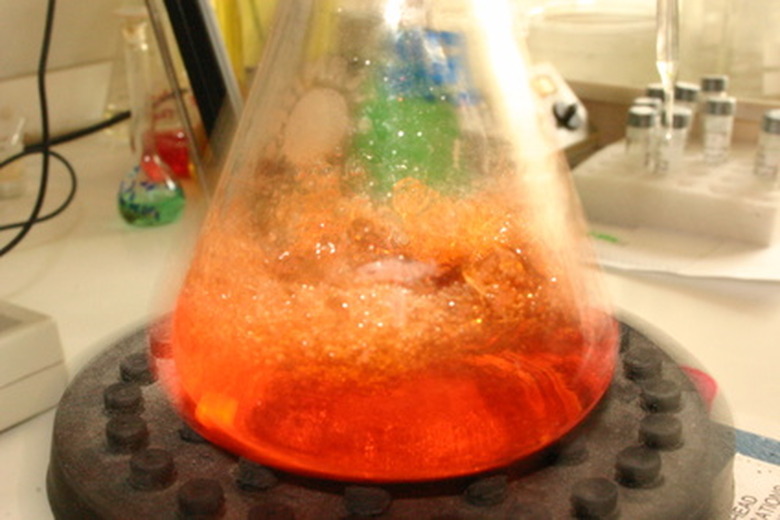Ideas For 8th-Grade Science Fair Projects
The origin of the school science fair can be traced back to 1941. Science Services, in conjunction with the American Institute of New York, created Science Clubs of America and established 800 clubs throughout the United States, which then developed fairs and competitions. An 8th grade science project can be simple or complex, but the aspiring scientist should begin the project early to make sure the data is complete and the exhibit is fully developed.
Cardinal Project
Cardinal Project
This project, which should be started a year before the science fair, will illustrate what types of food and bird feeders attract the most cardinals. You will need several types of bird feeders and food, as well as a pair of binoculars and a logbook. Place the feeders outside in random locations, such as shade, sunshine, near structures and out in the open. Place various types of food in the feeders. Periodically change the food types from feeder to feeder throughout the year. Use binoculars to note which combinations of food and feeder attract the most cardinals. Make the observations on a weekly basis and record your findings in the log. For your fair exhibit, create a chart that shows your findings. Display the feed and the bird feeders that you used.
DNA Detective
DNA Detective
This experiment will allow you to extract a DNA sample from your own cells. Add 1/2 teaspoon of salt to 1/2 cup of water and stir to dissolve. Add a squirt of dish soap to the mixture. Swish a tablespoon of plain water vigorously in your mouth for 30 seconds and spit it into a clean cup. This removes cheek cells. Place one teaspoon of the cheek cell water into a small, lidded container. Add 1/2 teaspoon of the saltwater/dish soap mixture and put on the lid. Mix it very gently by turning it upside down three or four times to break down the cells and release the DNA. Gently add a teaspoon of ice-cold rubbing alcohol to this mixture. Note the point where the two layers meet. Cloudy filaments should stretch into the top layer. This is the DNA forming because it is not soluble in alcohol. You may be able to extract one of the filaments with a hook made from a twist tie.
Sensory Confusion Experiment
Sensory Confusion Experiment
This experiment introduces the concept of "thermal-grill illusion," or sensory confusion. Fill a glass with cold water and add ice cubes. Place one knife, handle first, into the glass. Fill another glass with hot water. Place two knives, handles first, into the hot water for one minute. Remove the knives and insert the cold knife tightly between the two warm ones. Have a volunteer close his eyes and quickly touch all three handles to the inside of his wrist. He will feel a burning sensation more powerful than what he would feel from placing just the two warm handles in the same spot. This happens because when cold objects touch the skin they quickly stimulate the nerves that signal cold along with the nerves that slowly signal pain. The cold-transmitting nerves obstruct the pain-transmitting nerves, so normally only the cold is felt. However, the warm knives dilute the cold information leaving only the painful sensation.
Solar System Model
Solar System Model
A model of the solar system is a classic middle-school project, but you can make yours rise above the typical by adding a few special touches such as the Kuiper Belt. You'll need one large foam ball to represent the sun and eight balls of various sizes for the planets (nine if you want to include Pluto). Paint the balls to represent each planet. Use stiff wire to attach each planet the appropriate distance from the sun. The Kuiper Belt is a band of orbiting bodies just outside of Neptune. Create this by rolling crinkled newspaper into a circle. Paint the circle black, and then paint on asteroids with different colored paints. Use stiff wire to connect the belt to the sun, making sure it is in its appropriate spot just beyond Neptune. Place the sun on a secure wooden dowel. Place the model against a black background made from cloth or construction paper.
Cite This Article
MLA
Dumas, Robert. "Ideas For 8th-Grade Science Fair Projects" sciencing.com, https://www.sciencing.com/ideas-8thgrade-science-fair-projects-7908908/. 24 April 2017.
APA
Dumas, Robert. (2017, April 24). Ideas For 8th-Grade Science Fair Projects. sciencing.com. Retrieved from https://www.sciencing.com/ideas-8thgrade-science-fair-projects-7908908/
Chicago
Dumas, Robert. Ideas For 8th-Grade Science Fair Projects last modified August 30, 2022. https://www.sciencing.com/ideas-8thgrade-science-fair-projects-7908908/



